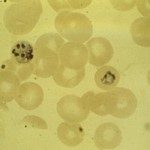Link to Pubmed [PMID] – 37393257
Link to DOI – 10.1186/s12936-023-04635-x
Malar J 2023 Jul; 22(1): 201
Plasmodium vivax malaria is now recognized as a cause of severe morbidity and mortality, resulting in a substantial negative effect on health especially in endemic countries. Accurate and prompt diagnosis and treatment of P. vivax malaria is vital for the control and elimination of the disease.A cross-sectional study was conducted from February 2021 to September 2022 at five malaria endemic sites in Ethiopia including Aribaminch, Shewarobit, Metehara, Gambella, and Dubti. A total of 365 samples that were diagnosed positive for P. vivax (mono and mixed infection) using RDT, site level microscopists and expert microscopists were selected for PCR. Statistical analyses were performed to calculate the proportions, agreement (k), frequencies, and ranges among different diagnostic methods. Fisher’s exact tests and correlation test were used to detect associations and relationship between different variables.Of the 365 samples, 324 (88.8%), 37(10.1%), 2 (0.5%), and 2 (0.5%) were P. vivax (mono), P. vivax/Plasmodium falciparum (mixed), P. falciparum (mono) and negative by PCR, respectively. The overall agreement of rapid diagnostic test (RDT), site level microscopy and expert microscopists result with PCR was 90.41% (k: 0.49), 90.96% (k: 0.53), and 80.27% (k: 0.24). The overall prevalence of sexual (gametocyte) stage P. vivax in the study population was 215/361 (59.6%). The majority of these 215 samples (180; 83.7%) had below 1000 parasites/µl, with only four samples (1.9%) had ≥ 5000 parasites/µl. The gametocyte density was found to be weakly positive but statically significant with asexual parasitaemia (r = 0.31; p < 0.001).Both microscopy and RDT showed moderate agreement with PCR in the detection and identification of P. vivax (mono) and P. vivax/P. falciparum (mixed) infections. Therefore, to achieve malaria elimination goals, strengthening routine malaria diagnostic methods by implementing diagnostic tools with a good performance in detecting and accurately identifying malaria species in clinical settings is recommended.

